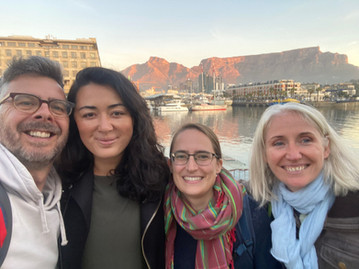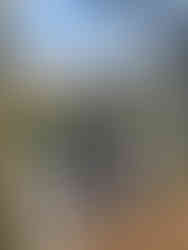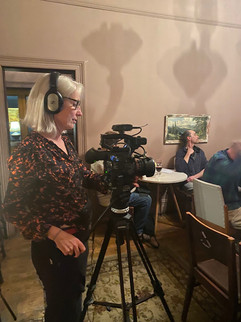In February 2022, we received a ‘Reignite Your Research’ grant from the University of Salford to make a short film associated with our project. The grant enabled filmmakers Simon Stanton-Sharma and Maire Tracey to join Sanja Nivesjö, Matthew Whittle (Kent) and myself on location in Cape Town. Here, we engaged local creatives in exploring the relationships between politics and aesthetics; the lasting impacts of colonialism and apartheid in and on South African art forms; and the relevance and legacies of local traditions, events, cultures, and historical figures, writers and artworks today.
The film captures interviews, readings, performances and artworks by musician Dizu Plaatjies, poet Zizipho Bam, artist/activist Haroon Gunn-Salie, and writer Sindiswa Busuku as they move between their homes, places of work, and various sites of inspiration in and around Cape Town.
The film will be screened as part of the nationwide Being Human Festival in November 2022, with the aim of extending and enhancing public engagement with key ideas associated with our project. The theme of the festival this year is ‘Breakthroughs’, and is in part inspired by the 2022 ‘centenary of several milestone breakthroughs, including […] the 100th anniversary of two breakthrough publications of literary modernism in English, James Joyce’s Ulysses and T.S. Eliot’s The Waste Land’ (‘Breakthroughs’ 2022 theme). 2022 is therefore also the ideal year in which to (re)introduce public audiences to the contributions made by South African artists, writers and thinkers to major artistic and philosophical movements - including modernism!
Our film offers a glimpse of South African creativity today, which remains just as vibrant and radical as it was 100 years ago, when writers such as Solomon T Plaatje, Nontsizi Mgqwetho, Henry Masila Ndawo, S E K Mqhayi, William Plomer, Roy Campbell, Enoch S Guma, Guybon Sinxo, R R R Dhlomo and H I E Dhlomo (amongst many others) were producing and publishing pioneering literature in various forms and languages.
The Film
The making of the film got off to a rather shaky start due to various flight cancellations, necessitating a last-minute train dash to Heathrow by Simon, Maire and Jade; a four-day delayed arrival by Matt; and a particularly unfortunate bout of covid, which prevented core team member Emma Barnes from joining us in South Africa. Despite these early challenges, Simon and Maire were able to commence work as planned on the first day of the shoot, which involved recces, shots and sound recordings of various locations in and around Cape Town.
On day two of the shoot we met Dizu Plaatjies at his home in Langa, where we learned about the historical, pedagogical and community importance of traditional instruments and music. He performed a recital on his homemade Umrhube, and explained how:
‘I started to be more connected with the traditional instruments when I started playing the Umrhube, Uhadi and flute. […] Today we’ve got a future from those instruments.’
Dizu’s incredible stories also spanned family reminiscences; his experiences performing as the lead member of major international band, Amapondo; and he even delighted us with an air-concertina rendition of Nelson Mandela’s favourite tune!


On days three and six we filmed Zizipho Bam reading and writing in some of her favourite locations, including at home, on the Chapman’s Peak drive, and at the beautiful Noordhoek beach.
She told us that:
‘I’ve always made sense of the world through poetry’.
For Zizipho, poetry allows her to capture her own and shared experiences of love, loss, trauma and joy as/of black womxn.
We also joined Zizipho at an Off the Wall Poetry event, where she performed alongside headliner Jerome Coetzee, as well as Stuart Payne, Jacques Coetzee, writers and food activists from the Food Agency Cape Town, and many others.

The Castle of Good Hope (a seventeenth-century Dutch East India Company fort) was the location for filming with Haroon Gunn-Salie on day four, where we viewed his installation Crying for Justice from the ramparts. The artwork comprises 118 graves that form the word ‘Justice’ - representing the 117 anti-apartheid activists known to die in detention, with the 118th grave a symbol of those whose deaths in detention remain unaccounted for.

We also filmed Haroon at his second site-specific intervention, Zonnebloem Renamed. In this artwork and act of restitution - which involved replacing all city-centre road signs for ‘Zonnebloem’ with ‘District Six’ - Haroon directly addresses the consequences of the Group Areas Act, which was used to forcibly remove over 60,000 residents from District Six in the 1970s to make way for a new ‘whites only’ area, Zonnebloem.
In Haroon's words:
‘What potential does art have to effect change? Infinite. Infinite.’
On the fifth day of the shoot we filmed Sindiswa Busuku at the English department at the University of Cape Town. The building in which she works is adjacent to both the burnt-out Jagger Library, and the site where the statue of Cecil Rhodes used to stand before #RhodesMustFall.

Sindiswa read from her forthcoming book, A Young Lilac Hungering, which endeavours to grapple with the pressing weight of history. She describes the book as motivated by her feelings of uncertainty, threat, restlessness and fear as well as her hopes for the world she finds herself in.
In her own words:
‘I don’t think the past is ever, ever, ever past. And the present is shaped by that.’
Though Dizu, Zizipho, Haroon and Sindiswa had never previously met, and did not meet until the final evening after the shoot had finished, their artworks and interviews reveal a number of shared themes and ideas. These include:
the importance of maintaining, reviving and reinterpreting traditions and traditional knowledges through new mediums, compositions and forms;
the vital role played by art, music and writing in the ongoing fights for social justice and equality in colonial, apartheid and post-apartheid contexts;
the enduring effects of the sundering and unresolved issue of racial inequality in South Africa, often in combination with other economic, social, and gender inequalities.
Perhaps most interestingly for the research team, these driving interests also resonate strongly with the writers whose work we examine as part of this project, including Olive Schreiner, Solomon Plaatje, William Plomer, Bessie Head, Lewis Nkosi, Can Themba and many others.
Shooting the film was an utterly brilliant experience, and I was endlessly impressed by the incredible talents of Simon, Maire, Dizu, Haroon, Zizipho and Sindiswa.
The footage is now being edited by Liza Ryan-Carter in preparation for the Being Human Festival in November, and we very much look forward to sharing the film with audiences soon – dates and times to follow!
On behalf of Simon Stanton-Sharma, Maire Tracey, Emma Barnes, Matthew Whittle, Sanja Nivesjö and myself, we would like to thank our contributors Dizu Plaatjies, Zizipho Bam, Haroon Gunn-Salie and Sindiswa Busuku; our funders the AHRC, University of Salford, University of Kent, Swedish Research Council, and the Birgit och Gad Rausings Stiftelse för Humanistisk forskning (Birgit and Gad Rausing's Foundation for Research in the Humanities); and collaborators, colleagues, friends and facilitators Andrew van der Vlies, Christopher Jangano Sithole, Aissa Parenti, Calvyn Gilfellan, Martin Bull, Caroline Magennis, Debra Prinselaar, Ric Michael, the Off the Wall poetry team, A Touch of Madness, and the Estates team at the University of Cape Town.





























